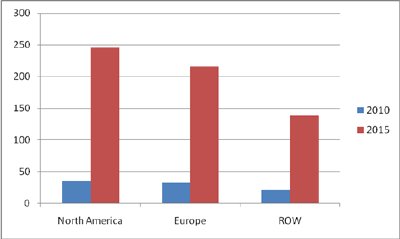Nov 22 2010
The thin-film battery (TFB) market is an attractive and still-growing multimillion-dollar market characterized by very high production volumes of thin-film batteries that must be extremely reliable and low in cost.
Thin-film lithium and lithium-ion batteries are ideally suited for a variety of applications where small power sources are needed. By using the available space within a device, the battery can provide the required power while occupying otherwise wasted space and adding negligible mass.

According to a recently published report from iRAP, Inc., EN106: Rechargeable and Non-Rechargeable, Flexible, Thin-Film Batteries: A Global Industry and Market Analysis, the global market for thin-film batteries is expected to reach $90 million in 2010. This market will increase to $600 million by 2015. The range for the average annual growth rate (AAGR) is expected to be 37.9% to 67.8% for the six major regions surveyed for the period 2010 to 2015. Regionally, North America is expected to capture about 40% of the market in 2010, followed by Europe at 36% and the rest of the world (ROW) at 24%, dominated by Japan, Korea and China.
Three very distinct types of flexible TFB technologies exist – lower performance printed TFBs, single-use higher performance lithium polymer (LiPo) batteries, and solid-state rechargeable lithium phosphorous oxynitride (LiPON) batteries (which are the most expensive). Currently, non-rechargeable zinc batteries can be fully printed and used in roll-to-roll manufacturing processes.
Major findings of this report include:
- The market for thin-film batteries used in one-time password (OTP), display-type smart cards for banking will be highest in 2010.
- Disposable medical cosmetic patches, electronic games and entertainment devices, music greeting cards using non-rechargeable thin printed battery (zinc-manganese chemistry), low power semi-active tags used with sensors, and battery-assisted passive (BAP) radio frequency identification (RFID) devices will have a combined market share of over one-third of the total market in 2010.
- Ultra-low power energy harvesting devices (solar, thermal, vibration) using rechargeable lithium-ion or similar type batteries will be a distant third in 2010.
- The main factor slowing growth of the market for thin-film/printed batteries at present is high cost. Thin-film/printable batteries are currently unable to compete with conventional battery technology on price. This will change as volumes for thin-film/printed batteries ramp up and technology improves. By far the largest application for these batteries is likely to be found in OTP display smart cards and battery-assisted, semi-passive RFID. There is much talk in the RFID industry about battery-assisted technology as a solution to the cost issue surrounding active RFID tags. By 2015, forecasts indicate that OTP display smart cards and battery-assisted passive RFID devices will take off.
- Among the three technologies covered in this report, in 2010 the market share for non-rechargeable thin zinc-manganese printed batteries is the highest followed by the lithium polymer thin-film non-rechargeable batteries and rechargeable thin-film lithium-ion batteries as a distant third.
Global market FOR thin-film FLEXIBLE batteries by region, through 2015 ($ Millions)
| |
2010
|
2015
|
|
| |
($ Millions)
|
Share %
|
($ Millions)
|
Share %
|
AAGR % 2010-15
|
| North America |
36.0
|
40
|
246
|
41
|
46.8
|
| Europe |
32.4
|
36
|
216
|
36
|
46.1
|
| ROW |
21.6
|
24
|
138
|
23
|
44.9
|
| TOTAL |
90
|
100
|
600
|
100
|
46.1
|